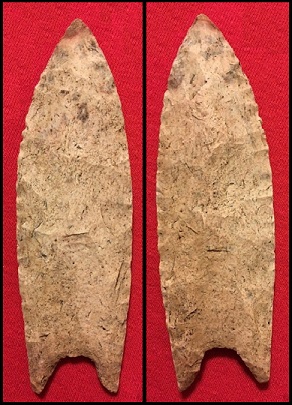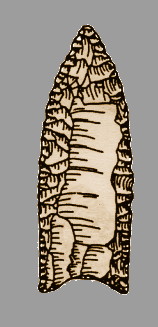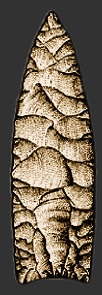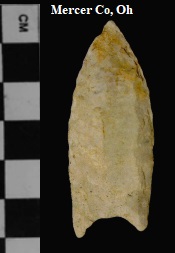Outline is Representative of Size and Shape:
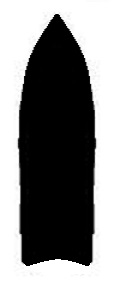

Name Details:
Identified By: Don Simons
Named For: Type Site
Date Identified: 1984
Type Site: Gainey Site, Genesee County, Michigan
Identified By: Don Simons
Named For: Type Site
Date Identified: 1984
Type Site: Gainey Site, Genesee County, Michigan
Point Validity:
Valid type
Simons is an archaeologist who has conducted many excavations in Michigan and published numerous professional publications. This type was named in a professional publication and has many professional references. This is considered a valid type.
Simons is an archaeologist who has conducted many excavations in Michigan and published numerous professional publications. This type was named in a professional publication and has many professional references. This is considered a valid type.
Gainey Fluted
Cluster: Clovis Cluster Description of Physical Characteristics and Flaking Pattern:
This is a medium to large (2.25 to 3.75 inches) lanceolate fluted point with a flattened cross section Points ten to be wide and thick with a 3-4 to 1 width to thickness ratio. These points are thinner, between the flutes, than other Clovis points. The cross section is flattened due to the flute. The blade is excurvate with the tip curving in and the edges becoming parallel. The blade may slightly contract towards the base, but this type does not have a constricting waist or a "fishtail" appearance. Unlike other Clovis point, the fluting platform on these points are similar to the fluting platforms used by Folsom and Cumberland type points. Each face may have one or multiple flutes. This technique creates long flutes generally extend one half to two thirds the way up the face and often lacks the step or hinge fracture termination. Pressure flaking used to remove the platform forms a deep basal concavity using the Barnes Finishing Technique**. Heavily re-sharpened examples may take on the appearance of a Folsom point. Grinding is seen on the basal and hafting region. The flaking pattern can range from random flaking to collateral or transverse flaking.
Size Measurements:
Length - 51 to 127 mm (68.4 mean), Width - 20 to 37 mm (26.9 mean), Thickness - 6 to 8.5 mm (7.6 mean), Basal Width - 19 to 32 mm (26.1 mean), Basal Concavity - 2.8 to 8.5 mm (4.9 mean)
Length - 51 to 127 mm (68.4 mean), Width - 20 to 37 mm (26.9 mean), Thickness - 6 to 8.5 mm (7.6 mean), Basal Width - 19 to 32 mm (26.1 mean), Basal Concavity - 2.8 to 8.5 mm (4.9 mean)
Commonly Utilized Material:
Onondaga Chert, Flint Ridge Chert, Upper Mercer Chert, Tenmile Creek Chert, and Collingwood Chert. Heat treatment techniques are not used on this point.
Onondaga Chert, Flint Ridge Chert, Upper Mercer Chert, Tenmile Creek Chert, and Collingwood Chert. Heat treatment techniques are not used on this point.
Additional Comments:
**Barnes Finishing Technique is a basal treatment which is characterized by the base of the flute being widened and and thinned by the subsequent removal of a single short broad flake.
This type was originally referred to as Bull Brook points by Roosa (1964), but it was discovered that this is a separate type and does not represent a northern distribution of the Bull Brook type (W14). This type is considered to be the earliest Paleo type point found in Michigan. The Barnes Type is thought to have followed up the Gainey type. This is based on the advanced flaking techniques that are seen on the Barnes Type and is generally lacking on the Gainey type points (Simons, 1984).
**Barnes Finishing Technique is a basal treatment which is characterized by the base of the flute being widened and and thinned by the subsequent removal of a single short broad flake.
This type was originally referred to as Bull Brook points by Roosa (1964), but it was discovered that this is a separate type and does not represent a northern distribution of the Bull Brook type (W14). This type is considered to be the earliest Paleo type point found in Michigan. The Barnes Type is thought to have followed up the Gainey type. This is based on the advanced flaking techniques that are seen on the Barnes Type and is generally lacking on the Gainey type points (Simons, 1984).
Distribution: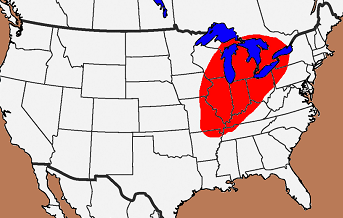

Distribution Comments:
This point is primarily found in the Great Lakes region of southern Ontario, eastern Michigan, northern Ohio, Wisconsin, and into western Pennsylvania and western New York. This point has been reported into the Mississippi River Valley with decreased frequency.
This point is primarily found in the Great Lakes region of southern Ontario, eastern Michigan, northern Ohio, Wisconsin, and into western Pennsylvania and western New York. This point has been reported into the Mississippi River Valley with decreased frequency.
Age / Periods:
Date: 12,500 - 10,000 B.P.
Cultural Period: Late Paleo
Glacial Period: Late Pleistocene
Culture:
Date: 12,500 - 10,000 B.P.
Cultural Period: Late Paleo
Glacial Period: Late Pleistocene
Culture:
Age Details:
Other points in this cluster / Related / Associated Points:


